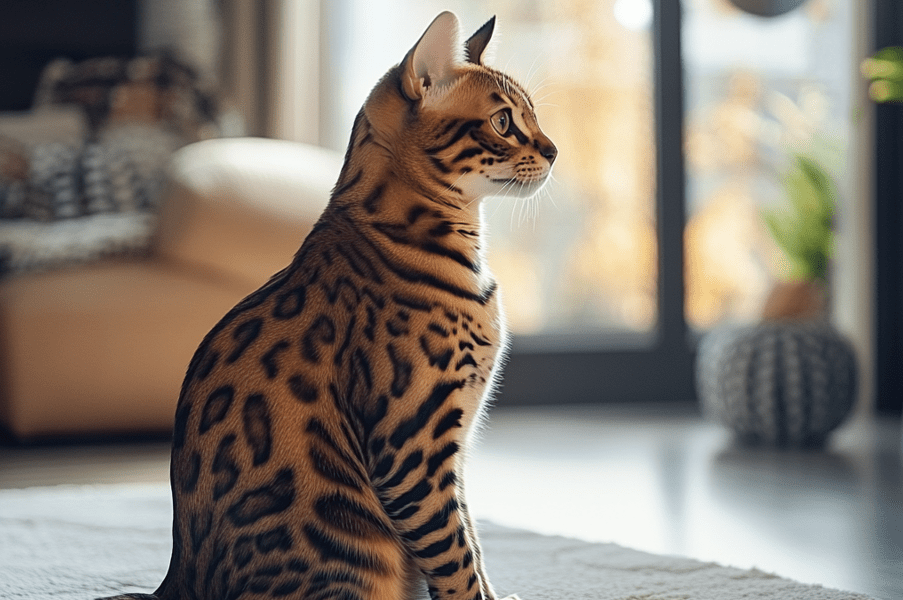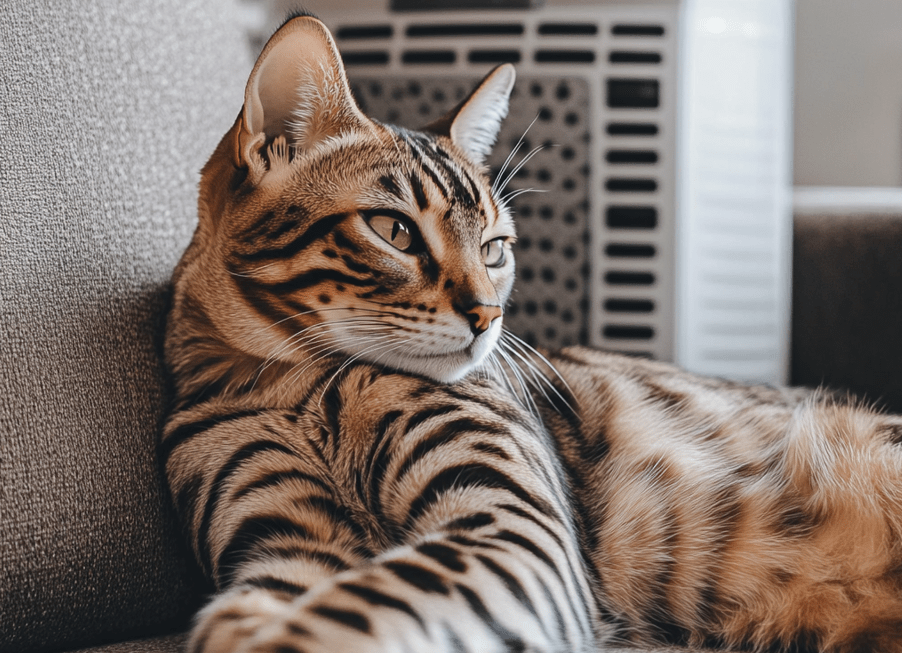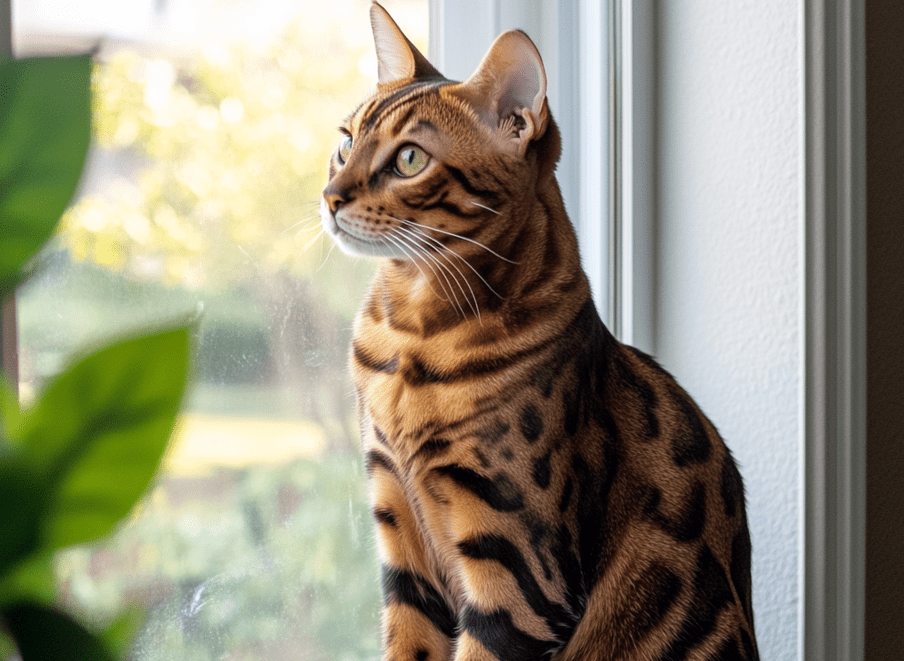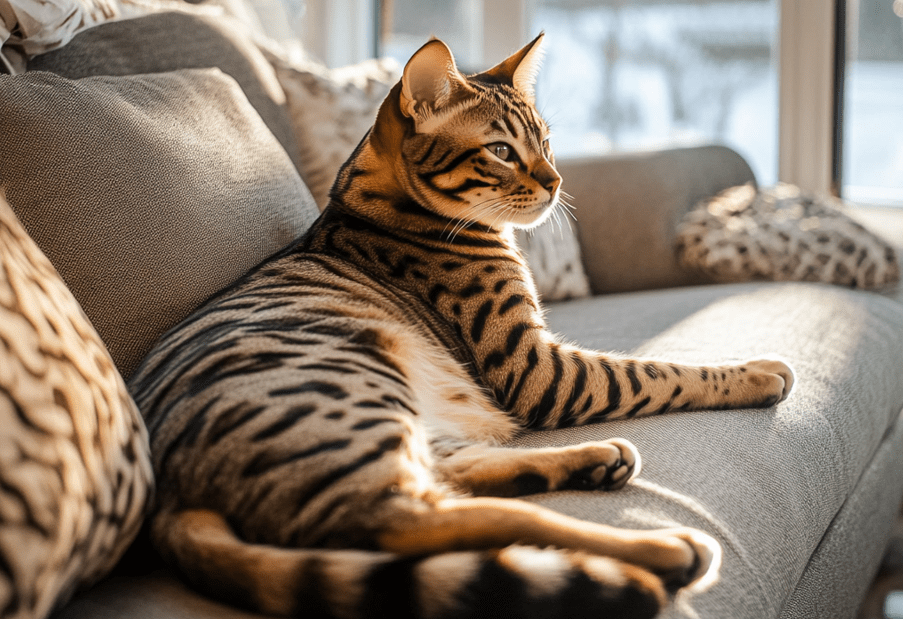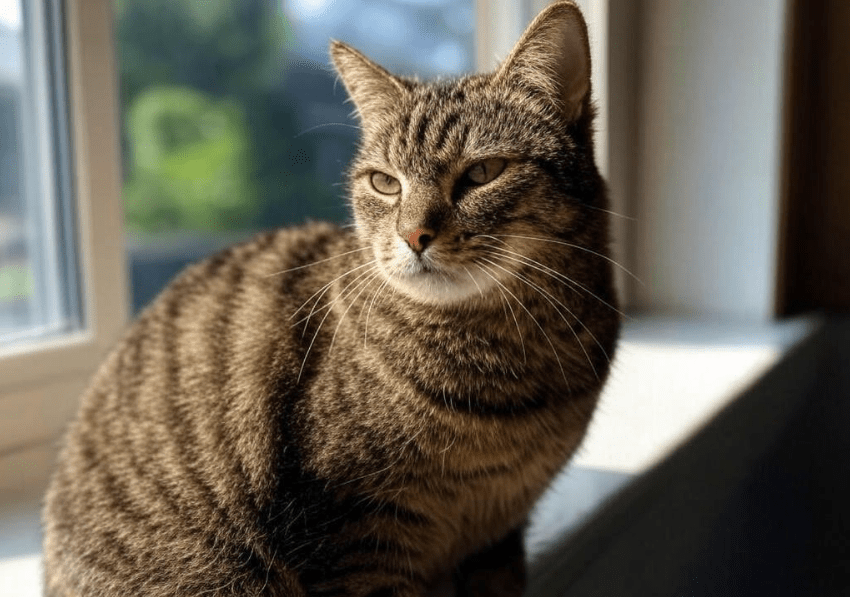
If you’re wondering, “Why is my Bengal cat so hyperactive?”, you’re not alone. Bengal cats are renowned for their boundless energy, playful antics, and spirited personalities, often leaving owners both amazed and exhausted. This hyperactivity is a hallmark of the breed, rooted in their unique genetics and instincts. However, understanding the reasons behind this behavior and learning how to channel their energy effectively can transform your Bengal’s zest into a positive, enriching part of your life together. This comprehensive guide explores the causes of Bengal hyperactivity and offers practical, stress-free strategies to keep your cat happy and engaged.
Understanding Bengal Cat Hyperactivity
Bengal cats are a hybrid breed, descended from the wild Asian leopard cat crossed with domestic felines. This heritage gives them a distinctive blend of wild instincts and domestic affection, resulting in their high-energy behavior. Their hyperactivity isn’t a flaw—it’s a natural expression of their intelligence, curiosity, and athleticism.
Why Is My Bengal Cat So Hyperactive?
Several factors contribute to a Bengal’s hyperactive nature:
Wild Ancestry: The Asian leopard cat’s predatory instincts drive Bengals to stalk, pounce, and explore, mimicking hunting behaviors.
High Intelligence: Bengals are exceptionally smart, requiring mental stimulation to avoid boredom-driven hyperactivity.
Physical Energy: Their athletic build demands regular exercise to burn off energy.
Youthful Exuberance: Young Bengals, especially kittens, are naturally more hyperactive, though this may mellow with age.
Environmental Triggers: Lack of stimulation, small living spaces, or changes in routine can amplify their energy.
Is Hyperactivity Normal for Bengals?
Yes, hyperactivity is entirely normal for Bengal cats, especially compared to more sedentary breeds. Their energy levels are a feature of their breed, not a sign of misbehavior. However, excessive or destructive hyperactivity may indicate unmet needs, such as insufficient exercise, mental stimulation, or environmental enrichment.
When to Be Concerned
While hyperactivity is typical, watch for signs that it may be problematic:
Destructive Behavior: Scratching furniture, knocking over items, or chewing excessively.
Restlessness: Inability to settle, even after play.
Aggression: Biting or scratching during play, indicating overstimulation.
Sudden Changes: A sudden spike in hyperactivity could signal stress, anxiety, or health issues.
If you notice these signs, consult a veterinarian to rule out medical causes like hyperthyroidism or pain, and consider behavioral adjustments.
LSI Keywords: Bengal cat destructive behavior, signs of cat stress, hyperactive cat health.
Reasons Behind Bengal Cat Hyperactivity
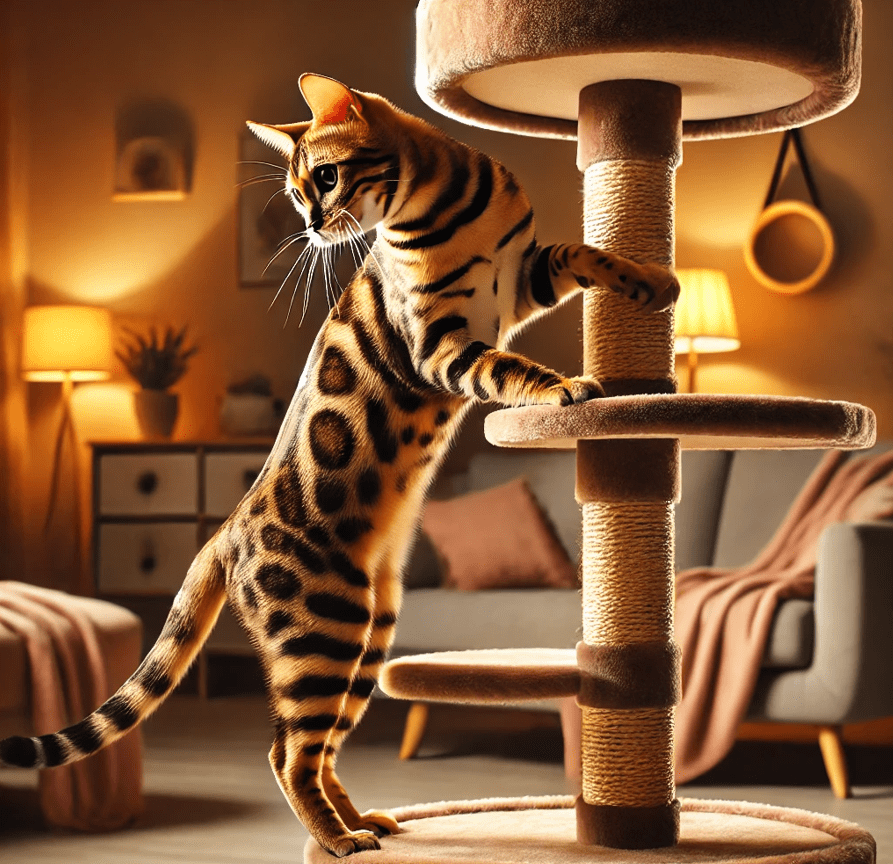
To effectively manage your Bengal’s energy, it’s crucial to understand the specific drivers of their hyperactivity. Here are the primary reasons:
1. Genetic Predisposition
Bengals inherit their high energy from their wild ancestors, who needed to hunt, climb, and explore to survive. This instinct manifests as running, jumping, and playful “hunting” behaviors, even in a domestic setting.
2. Need for Mental Stimulation
Bengals are problem-solvers with sharp minds. Without puzzles, games, or challenges, they may become hyperactive to entertain themselves, often leading to mischief like ambushing or climbing curtains.
3. Lack of Physical Exercise
Bengals require more exercise than many other breeds. Without sufficient outlets, their pent-up energy can result in zooming around the house or destructive antics.
4. Boredom and Lack of Enrichment
A dull environment can exacerbate hyperactivity. Bengals thrive in spaces with vertical perches, toys, and opportunities to explore.
5. Social Needs
Bengals are social and may act out if left alone for long periods. Hyperactivity can be a bid for attention or a response to loneliness.
6. Diet and Health
A diet lacking proper nutrients or underlying health issues (e.g., hyperthyroidism) can influence energy levels. Ensure your Bengal’s diet is balanced and consult a vet if hyperactivity seems abnormal.
How to Channel Your Bengal’s Energy
Managing your Bengal’s hyperactivity involves redirecting their energy into positive, engaging activities. Below are practical, humane strategies to keep your cat stimulated and content.

1. Provide Ample Physical Exercise
Regular exercise is essential to burn off your Bengal’s energy and reduce hyperactivity.
Interactive Play Sessions: Dedicate 20–30 minutes twice daily to active play using feather wands, laser pointers, or balls. Mimic prey movements to engage their hunting instincts.
Cat Wheels: A cat exercise wheel allows your Bengal to run at their own pace, ideal for high-energy cats.
Outdoor Adventures: If safe, leash-train your Bengal for supervised outdoor walks to explore new environments.
Climbing Structures: Install cat trees, shelves, or wall-mounted perches to encourage jumping and climbing.
Pro Tip: Vary play activities to keep your Bengal engaged and prevent boredom.
2. Engage Their Minds with Mental Stimulation
Bengals need intellectual challenges to stay satisfied. Mental stimulation can reduce hyperactivity by keeping their minds occupied.
Puzzle Toys: Use treat-dispensing balls, puzzle boards, or foraging toys to challenge problem-solving skills.
Clicker Training: Teach tricks like “sit,” “fetch,” or navigating an obstacle course. Bengals’ intelligence makes them quick learners.
Scent Games: Hide treats or catnip-scented toys around the house for your Bengal to “hunt.”
DIY Challenges: Create a puzzle by hiding kibble in a muffin tin covered with tennis balls.
3. Create a Stimulating Environment
A Bengal-friendly environment prevents boredom and channels energy constructively.
Vertical Spaces: Provide tall cat trees, window perches, or wall shelves for climbing and observing.
Window Views: Place a perch near a window for bird-watching or outdoor entertainment.
Hiding Spots: Offer tunnels, cardboard boxes, or cat condos for exploration and rest.
Rotate Toys: Swap out toys weekly to maintain novelty and prevent disinterest.
4. Use Technology for Engagement
Modern pet tech can keep your Bengal entertained, especially when you’re away.
Automated Toys: Motion-activated balls, robotic mice, or timed laser toys provide spontaneous play.
Interactive Pet Cameras: Devices like Petcube let you monitor, talk to, or play with your Bengal remotely via laser pointers or treat dispensers.
Cat Videos: Play videos of birds, fish, or scurrying mice on a secure tablet or TV to captivate their attention.
5. Establish a Routine
Bengals thrive on consistency. A predictable schedule for feeding, play, and rest reduces stress and helps manage hyperactivity.
Morning Play: Start the day with an active session to burn energy.
Midday Enrichment: Leave puzzle toys or automated toys for solo play.
Evening Bonding: End with interactive play and cuddles to wind down.
6. Social Interaction and Companionship
Bengals are social and may become hyperactive if lonely. Providing companionship can help.
Playmate: If compatible, a second cat or cat-friendly dog can provide a play partner, reducing attention-seeking hyperactivity.
Quality Time: Spend dedicated time daily engaging with your Bengal to fulfill their social needs.
Remote Interaction: Use pet cameras to check in and interact when away.
7. Optimize Diet and Health
A balanced diet supports healthy energy levels, while health issues can exacerbate hyperactivity.
High-Quality Diet: Feed a protein-rich, balanced diet formulated for active cats. Consult your vet for recommendations.
Portion Control: Avoid overfeeding, which can lead to excess energy or obesity.
Veterinary Checkups: Rule out medical causes like hyperthyroidism, parasites, or nutritional deficiencies if hyperactivity seems extreme.
Common Mistakes to Avoid
When managing your Bengal’s hyperactivity, steer clear of these pitfalls:
Punishment: Yelling or spraying water causes stress and may worsen behavior. Use positive reinforcement instead.
Insufficient Exercise: Underestimating their need for activity can lead to destructive hyperactivity.
Monotonous Environment: A lack of variety in toys or spaces can bore your Bengal, increasing restlessness.
Inconsistent Routines: Irregular schedules can cause stress and amplify hyperactivity.
Ignoring Health Issues: Always consult a vet if hyperactivity seems sudden or excessive.
When to Seek Professional Help
If your Bengal’s hyperactivity remains unmanageable or is accompanied by concerning symptoms, professional support may be needed.
1. Veterinary Evaluation
Sudden or extreme hyperactivity could indicate health issues like:
-
Hyperthyroidism
-
Pain or discomfort
-
Neurological conditions
-
Nutritional imbalances
A vet can perform tests to diagnose and treat underlying problems.
2. Feline Behaviorist
A certified cat behaviorist can assess your Bengal’s environment, routine, and behavior to create a tailored plan for managing hyperactivity. They may recommend specific enrichment strategies or calming techniques.
3. Stress Management
If stress or anxiety drives hyperactivity, a behaviorist might suggest pheromone diffusers, calming supplements, or environmental changes to create a more soothing space.
Fun Ways to Channel Hyperactivity
Turn your Bengal’s energy into a bonding opportunity with these engaging activities:
Obstacle Course: Build a home course with tunnels, boxes, and perches. Guide your Bengal through with a toy to mimic a hunt.
Water Play: Many Bengals love water. Float toys in a shallow container or use a pet fountain for playful splashing.
DIY Toys: Create a feather wand or treat-stuffed cardboard tube for budget-friendly fun.
Hide-and-Seek: Hide treats or toys around the house for your Bengal to find, satisfying their hunting instincts.
Conclusion

Understanding why your Bengal cat is so hyperactive is the first step to creating a fulfilling life for both you and your pet. Their high energy, driven by wild instincts and sharp intelligence, is a unique trait that can be harnessed through exercise, mental stimulation, and a stimulating environment. By implementing the strategies in this guide—interactive play, enrichment, routines, and more—you can channel your Bengal’s energy into positive, fun activities. Start today, and enjoy a happier, healthier, and more harmonious relationship with your spirited Bengal companion.

